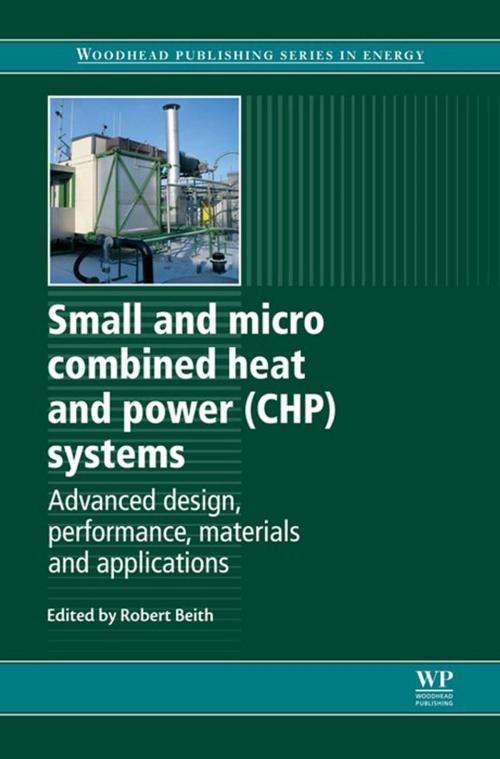Small and Micro Combined Heat and Power (CHP) Systems
Advanced Design, Performance, Materials and Applications
Nonfiction, Science & Nature, Technology, Power Resources| Author: | ISBN: | 9780857092755 | |
| Publisher: | Elsevier Science | Publication: | April 30, 2011 |
| Imprint: | Woodhead Publishing | Language: | English |
| Author: | |
| ISBN: | 9780857092755 |
| Publisher: | Elsevier Science |
| Publication: | April 30, 2011 |
| Imprint: | Woodhead Publishing |
| Language: | English |
Small and micro combined heat and power (CHP) systems are a form of cogeneration technology suitable for domestic and community buildings, commercial establishments and industrial facilities, as well as local heat networks. One of the benefits of using cogeneration plant is a vastly improved energy efficiency: in some cases achieving up to 80–90% systems efficiency, whereas small-scale electricity production is typically at well below 40% efficiency, using the same amount of fuel. This higher efficiency affords users greater energy security and increased long-term sustainability of energy resources, while lower overall emissions levels also contribute to an improved environmental performance.
Small and micro combined heat and power (CHP) systems provides a systematic and comprehensive review of the technological and practical developments of small and micro CHP systems.
Part one opens with reviews of small and micro CHP systems and their techno-economic and performance assessment, as well as their integration into distributed energy systems and their increasing utilisation of biomass fuels. Part two focuses on the development of different types of CHP technology, including internal combustion and reciprocating engines, gas turbines and microturbines, Stirling engines, organic Rankine cycle process and fuel cell systems. Heat-activated cooling (i.e. trigeneration) technologies and energy storage systems, of importance to the regional/seasonal viability of this technology round out this section. Finally, part three covers the range of applications of small and micro CHP systems, from residential buildings and district heating, to commercial buildings and industrial applications, as well as reviewing the market deployment of this important technology.
With its distinguished editor and international team of expert contributors, Small and micro combined heat and power (CHP) systems is an essential reference work for anyone involved or interested in the design, development, installation and optimisation of small and micro CHP systems.
- Reviews small- and micro-CHP systems and their techno-economic and performance assessment
- Explores integration into distributed energy systems and their increasing utilisation of biomass fuels
- Focuses on the development of different types of CHP technology, including internal combustion and reciprocating engines
Small and micro combined heat and power (CHP) systems are a form of cogeneration technology suitable for domestic and community buildings, commercial establishments and industrial facilities, as well as local heat networks. One of the benefits of using cogeneration plant is a vastly improved energy efficiency: in some cases achieving up to 80–90% systems efficiency, whereas small-scale electricity production is typically at well below 40% efficiency, using the same amount of fuel. This higher efficiency affords users greater energy security and increased long-term sustainability of energy resources, while lower overall emissions levels also contribute to an improved environmental performance.
Small and micro combined heat and power (CHP) systems provides a systematic and comprehensive review of the technological and practical developments of small and micro CHP systems.
Part one opens with reviews of small and micro CHP systems and their techno-economic and performance assessment, as well as their integration into distributed energy systems and their increasing utilisation of biomass fuels. Part two focuses on the development of different types of CHP technology, including internal combustion and reciprocating engines, gas turbines and microturbines, Stirling engines, organic Rankine cycle process and fuel cell systems. Heat-activated cooling (i.e. trigeneration) technologies and energy storage systems, of importance to the regional/seasonal viability of this technology round out this section. Finally, part three covers the range of applications of small and micro CHP systems, from residential buildings and district heating, to commercial buildings and industrial applications, as well as reviewing the market deployment of this important technology.
With its distinguished editor and international team of expert contributors, Small and micro combined heat and power (CHP) systems is an essential reference work for anyone involved or interested in the design, development, installation and optimisation of small and micro CHP systems.
- Reviews small- and micro-CHP systems and their techno-economic and performance assessment
- Explores integration into distributed energy systems and their increasing utilisation of biomass fuels
- Focuses on the development of different types of CHP technology, including internal combustion and reciprocating engines















